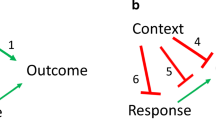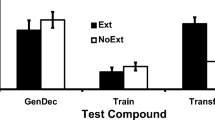Summary
Twenty-four rats received 54 differential instrumental conditioning trials (single stimulus presentation) in which an approach to one stimulus was reinforced and to a second was nonreinforced, followed by 24 extinction trials in which approaches to either were nonreinforced. Twelve animals received a 20 mg/kg amobarbital sodium injection (i. p.) ten minutes before the six daily trials and 12 received an equal volume isotonic saline injection. The drug did not affect terminal response latency to the reinforced stimulus but resulted in shorter latencies to the nonreinforced stimulus in both initial acquisition and extinction. These data support the hypothesis that amobarbital at this dose level has a specific attenuating effect on those anticipatory processes related to aversive emotion-producing events.
Similar content being viewed by others
References
Barry, H., A. R. Wagner, and N. E. Miller: Effects of alcohol and amobarbital on performance inhibited by experimental extinction. J. comp. physiol. Psychol. 55, 464–468 (1962).
Chi, Carl C.: The effect of amobarbital sodium on conditioned fear as measured by the potentiated startle response in rats. Psychopharmacologia (Berl.) 7, 115–122 (1965).
Davis, J. D., and N. E. Miller: Fear and pain: their effect on self-injection of amobarbital sodium by rats. Science 141, 1286–1287 (1963).
Dews, P. B.: A behavioral effect of amobarbital. Naunyn-Schmiedebergs Arch. exp. Path. Pharmak. 248, 296–307 (1964).
-, and W. H. Morse: Behavioral pharmacology. Ann. Rev. Pharmacol. 1961, 145–174.
Domino, E. F., D. F. Caldwell, and R. Henke: Effects of psychoactive agents on acquisition of conditioned pole jumping in rats. Psychopharmacologia (Berl.) 8, 285–289 (1965).
Ferster, C. B., J. B. Appel, and R. A. Hiss: The effects of drugs on a fixed-ratio performance suppressed by a pre-time-out stimulus. J. exp. Anal. Behav. 5, 73–88 (1962).
Goldstein, H., and K. W. Spence: Performance in differential conditioning as a function of variation in magnitude of reward. J. exp. Psychol. 65, 86–93 (1963).
Granjean, E., u. K. Bättig: Die Wirkung verschiedener Psychopharmaka auf die spontane Alternation der Ratte. Helv. physiol. pharmacol. Acta 20, 373–381 (1962).
Hunt, H. F.: Methods for studying the behavioral effects of drugs. Ann. Rev. Pharmacol. 1961, 125–144.
Ison, J. R., D. H. Glass, and H. M. Bohmer: The effects of sodium amytal on the approach to stimulus change. Proc. Amer. psychol. Ass. 1966, 5–6.
Kamano, D. K., L. K. Martin, and B. J. Powell: Avoidance response acquisition and amobarbital dosage levels. Psychopharmacologia (Berl.) 8, 319–323 (1966a).
— —, and B. J. Powell: Effects of amobarbital on the conditoned emotional response and conditioned acoidance response. Psychol. Rec. 16, 13–16 (1966b).
Lindquist, E. F.: Design and analysis of experiments in psychology and education. Boston: Houghton Mifflin 1953.
Lynch, V. C., M. C. G. Aceto, and R. K. Thoms: Effects of certain psychopharmacologic drugs on conditioning in the rat. I. Avoidance-escape conditioning. J. Amer. pharm. Ass. 49, 205–210 (1960).
Maynert, E. W.: Sedatives and hypnotics II: Barbiturates. In J. R. Di Palma (Ed.): Drill's Pharmacology in Medicine, Third Edition, pp. 188–209. New York: McGraw-Hill 1965.
Miller, N. E.: The analysis of motivational effects illustrated by experiments on amylobarbitone sodium. In H. Steinberg, A. V. S. de Reuck, and J. Knight (Eds.): Ciba Foundation Symposium, Jointly with the Co-ordinating Committee for Symposia on Drug Action, on Animal Behavior and Drug Action, pp. 1–18. London: Churchill 1964.
Morse, W. H.: Use of operant conditioning techniques for evaluating the effects of barbiturates on behavior. In J. H. Nodine and J. H. Moyer (Eds.): First Hahnemann Symposium on Psychosomatic Medicine, pp. 275–281. Philadelphia: Lea and Febiger 1962.
Rushton, R., and H. Steinberg: Mutual potentiation of amphetamine and amylobarbitone measured by activity in rats. Brit. J. Pharmacol. 21, 295–305 (1963).
Sinha, S. N., C. M. Franks, and P. L. Broadhurst: The effect of a stimulant and a depressant drug on a measure of reactive inhibition. J. exp. Psychol. 56, 349–354 (1958).
Skinner, B. F.: Are theories of learning necessary. Psychol. Rev. 50, 193–216 (1950).
Terrace, H. S.: Stimulus control. In W. K. Honig (Ed.): Operant behavior, pp. 271–344. New York: Appleton-Century-Crofts 1966.
Author information
Authors and Affiliations
Additional information
This research was supported by National Science Foundation grants GB 1505 and GB 4373 to J. R. Ison.
Rights and permissions
About this article
Cite this article
Ison, J.R., Rosen, A.J. The effects of amobarbital sodium on differential instrumental conditioning and subsequent extinction. Psychopharmacologia 10, 417–425 (1967). https://doi.org/10.1007/BF00403982
Received:
Issue Date:
DOI: https://doi.org/10.1007/BF00403982




